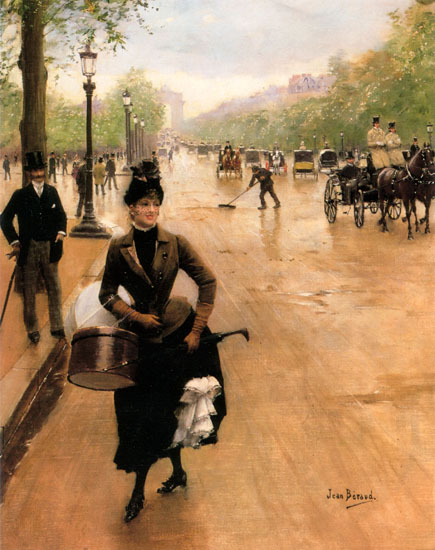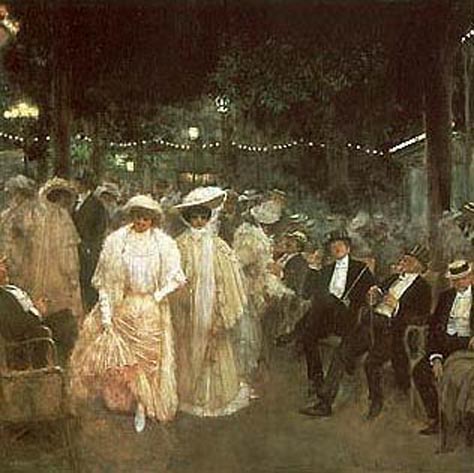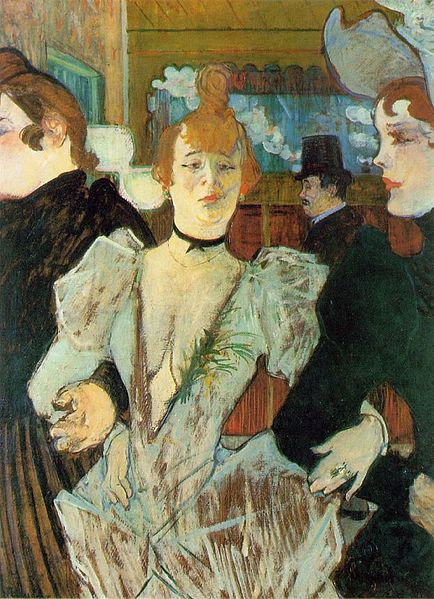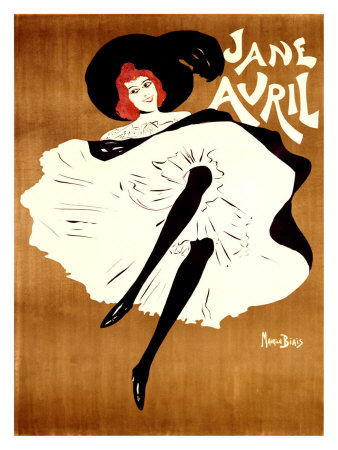
Jane Avril (1868–1943) was a French can-can dancer made famous by Henri de Toulouse-Lautrec through his paintings. Extremely thin, 'given to jerky movements and sudden contortions', she was nicknamed La Mélinite, after an explosive.
She was born Jeanne Beaudon in Belleville,
 on June 9, 1868
on June 9, 1868 (Though her biographer, Shercliff - whose account of the dancer's life is highly romanticised
(Though her biographer, Shercliff - whose account of the dancer's life is highly romanticised  - used the surname Richepin in her publication).
- used the surname Richepin in her publication). Her mother was a courtesan and her absent father, allegedly, was a foreign aristocrat.
Her mother was a courtesan and her absent father, allegedly, was a foreign aristocrat. Abused as a child, she ran away from home, and was eventually admitted to the Salpêtrière Hospital,
Abused as a child, she ran away from home, and was eventually admitted to the Salpêtrière Hospital, with the movement disorder 'St Vitus' Dance' (now thought to be Sydenham's Chorea)
with the movement disorder 'St Vitus' Dance' (now thought to be Sydenham's Chorea) . patients with Sydenham's chorea develop rapid and purposeless involuntary motions or gestures that may involve all the muscles of the body, except those around
. patients with Sydenham's chorea develop rapid and purposeless involuntary motions or gestures that may involve all the muscles of the body, except those around  the eyes. Most patients are affected on both sides of the body; however, about 20% have symptoms on only side
the eyes. Most patients are affected on both sides of the body; however, about 20% have symptoms on only side of the body, a condition called hemichorea. The movements disappear during sleep, but usually become more severe when the child is tired or under stress.
of the body, a condition called hemichorea. The movements disappear during sleep, but usually become more severe when the child is tired or under stress.  The patient's intentional movements such as picking up objects or writing by hand may become clumsy or uncoordinated; in addition, the muscles may become generally weak or lose their tone. In milder cases of Sydenham's, the patient may have only facial grimacing and some difficulty putting on clothes or doing other tasks that require fine coordination. In more severe cases, however, the patient's life may be disrupted by movements that affect large groups of muscles, preventing the patient from walking, going to school, or doing most daily activities.Under the care of Dr. Jean-Martin Charcot, the expert on "female hysterics" she received various kinds of treatment, and claimed in her biography that, when she discovered dance at a social dance for employees and patients at the hospital, she was cured. On leaving the hospital, after a failed romance, oJeanne thought to kill herself, but was taken in by the Madame of a Parisian brothel.As a result of financial assistance from Monsieur Hutt (Elise's former lover) and Viscount de Saincourt (somewhat dubious character who had an involvement with Elise) Jeanne was able to continue her education at the Academy of Demoiselles Désir. Jeanne would be happy again
The patient's intentional movements such as picking up objects or writing by hand may become clumsy or uncoordinated; in addition, the muscles may become generally weak or lose their tone. In milder cases of Sydenham's, the patient may have only facial grimacing and some difficulty putting on clothes or doing other tasks that require fine coordination. In more severe cases, however, the patient's life may be disrupted by movements that affect large groups of muscles, preventing the patient from walking, going to school, or doing most daily activities.Under the care of Dr. Jean-Martin Charcot, the expert on "female hysterics" she received various kinds of treatment, and claimed in her biography that, when she discovered dance at a social dance for employees and patients at the hospital, she was cured. On leaving the hospital, after a failed romance, oJeanne thought to kill herself, but was taken in by the Madame of a Parisian brothel.As a result of financial assistance from Monsieur Hutt (Elise's former lover) and Viscount de Saincourt (somewhat dubious character who had an involvement with Elise) Jeanne was able to continue her education at the Academy of Demoiselles Désir. Jeanne would be happy againWorking at whatever day jobs were available, at night she pursued a career in dancing by performing at local clubs. In 1888, she met the writer René Boylesve (1867–1926)
 who is said to have become quite taken by the beautiful but shy young girl. Using the stage name Jane Avril, she built a reputation that eventually allowed her to make a living as a full-time dancer. Hired by the Moulin Rouge nightclub in 1889,
who is said to have become quite taken by the beautiful but shy young girl. Using the stage name Jane Avril, she built a reputation that eventually allowed her to make a living as a full-time dancer. Hired by the Moulin Rouge nightclub in 1889, within a few years she headlined at the Jardin de Paris,
within a few years she headlined at the Jardin de Paris, one of the major café-concerts on the Champs-Élysées. To advertise the extravaganza, Henri de Toulouse-Lautrec painted her portrait on a poster that elevated her stature in the entertainment world even further. The popularity of the Cancan
one of the major café-concerts on the Champs-Élysées. To advertise the extravaganza, Henri de Toulouse-Lautrec painted her portrait on a poster that elevated her stature in the entertainment world even further. The popularity of the Cancan  became such that Jane Avril travelled with a dance troupe to perform in London.It is a myth that the cancan was ever frequently danced without drawers. This mistaken belief has taken root probably because when the cancan first appeared in working-class dance halls in the 1830s, drawers were not a standard item of underwear. They were adopted in the 1850s because of the advent of the hooped skirt or crinoline. Initially drawers were of the "open" type, being essentially two tubes of material, one for each leg, and this is perhaps another reason for the myth. However, the Moulin Rouge management did not permit dancers to perform in such revealing garments
became such that Jane Avril travelled with a dance troupe to perform in London.It is a myth that the cancan was ever frequently danced without drawers. This mistaken belief has taken root probably because when the cancan first appeared in working-class dance halls in the 1830s, drawers were not a standard item of underwear. They were adopted in the 1850s because of the advent of the hooped skirt or crinoline. Initially drawers were of the "open" type, being essentially two tubes of material, one for each leg, and this is perhaps another reason for the myth. However, the Moulin Rouge management did not permit dancers to perform in such revealing garments
In 1895, the owners of the Moulin Rouge offered her a great deal of money to take on the risky task of replacing Louise Weber, the most famous dancer in Paris, known by her stage name as "La Goulue"

Very little is known about her early childhood, but it is believed that Louise Weber was born into a Jewish family
 from Alsace that eventually moved to Clichy
from Alsace that eventually moved to Clichy , near Paris.
, near Paris. Her mother worked in a laundry. As an impoverished young girl who loved to dance,
Her mother worked in a laundry. As an impoverished young girl who loved to dance,  Weber is said to have enjoyed dressing up in laundry customers' expensive clothing and pretending to be a glamorous star on a great stage. At age 16, she was working with her mother in the laundry, but behind her mother's back began sneaking off to a dance hall dressed in one of their customer's "borrowed" dr
Weber is said to have enjoyed dressing up in laundry customers' expensive clothing and pretending to be a glamorous star on a great stage. At age 16, she was working with her mother in the laundry, but behind her mother's back began sneaking off to a dance hall dressed in one of their customer's "borrowed" dr . Graceful, soft-spoken, and melancholic, Jane Avril gave a dance presentation that was the opposite of the very bodacious La Goulue.
. Graceful, soft-spoken, and melancholic, Jane Avril gave a dance presentation that was the opposite of the very bodacious La Goulue.A woman of intelligence and with a sense of aloof grace, at age 42 she met and married the German artist, Maurice Biais
 (c.1875–1926), and the couple moved to a home in Jouy-en-Josas a
(c.1875–1926), and the couple moved to a home in Jouy-en-Josas a t the outskirts of Paris. However, her husband soon began to stray, often disappearing for days at a time, and for years she lived a miserable existence with the irresponsible Biais. Without any financial support following his death in 1926, Avril lived in near poverty on what little was left of her savings.
t the outskirts of Paris. However, her husband soon began to stray, often disappearing for days at a time, and for years she lived a miserable existence with the irresponsible Biais. Without any financial support following his death in 1926, Avril lived in near poverty on what little was left of her savings.
Above poster by her german husbandJane Avril died in a seniors' home in 1943 at the age of 75. She was interred in the Père Lachaise Cemetery in Paris.

Zsa Zsa Gabor portrayed Avril in the original Moulin Rouge (1952); half a century later, the semi-fictionalized character was reinterpreted by Nicole Kidman in Moulin Rouge! (2001). Avril is one of the characters in Per Olov Enquist's book The Book of Blanche and Marie, which portrays the lives of Blanche Wittman and Marie Curie.

No comments:
Post a Comment